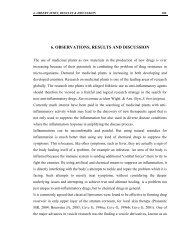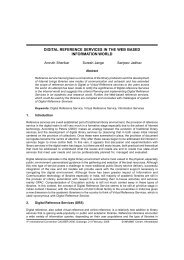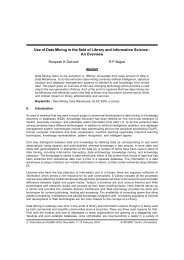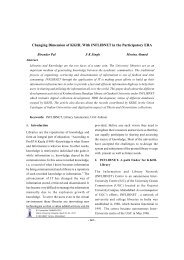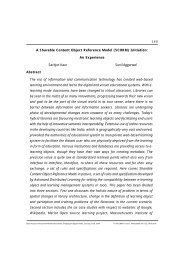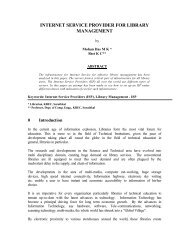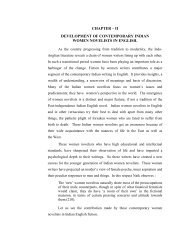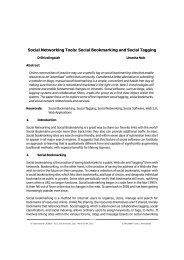<strong>Planning</strong> <strong>for</strong> <strong>Library</strong> <strong>Automation</strong>: <strong>Academic</strong> <strong>Libraries</strong> 15------------------------------------------------------------------------------------------------------------------------------------------Essentially, what this means is that libraries must plan to use a local library system as a vehicle <strong>for</strong>achieving access to resources outside that system. Stimulated by the Internet, which has created universalconnectivity to in<strong>for</strong>mation resources hereto<strong>for</strong>e unknown and/or inaccessible, and by Z39.50interoperability standards and "gateways," users of individual local systems are expecting to access theresources of other systems-- anywhere and anytime. Moreover, the traditional definition of "publishing"has been stretched by the creation and instant availability of in<strong>for</strong>mational home pages and Web sitesworldwide.Given such increased complexities and heightened levels of expectation, libraries must learn all the morehow to plan <strong>for</strong> the introduction of automation in an organized and systematic fashion. There is littlemystery involved here: It is entirely a matter of building upon what you already know about your library,using tools that are readily at hand and, most importantly of all, involving the people -- staff and users --who must live with the consequences of any automation decisions.WHAT IS LIBRARY AUTOMATIONTraditional library work consisting of acquisitions, technical processing, serials control, circulation andreference services all entail time consuming manual work. Though these activities are essential to properfunctioning of a library, they consume professional staff time that might otherwise go towards userservices and library development. <strong>Library</strong> computerization is now gaining importance necessitating theestablishment of profession-wide standards. Comprehensive studies of library computer systems worldover include discussions of machine-managed acquisitions, cataloguing, serials control, circulation andbibliographic service modules. The literature in this area highlights major aspects of computer’s role inthe library environment. Similar to several aspects of library management, the demand <strong>for</strong> more and fasterin<strong>for</strong>mation services and the decline in library resources are compelling librarians to appreciate the role ofcomputers within their operations. In general, librarians are looking to maximize the benefits ofautomation by spreading computer use to as many aspects of library activities as possible by takingadvantage of developments in computer hardware and software and telecommunications.NEED FOR LIBRARY AUTOMATIONEven though this question seems to be very fundamental it is essential to emphasize this aspect, as thelibrary automation is yet to take off in majority of the Indian libraries. Secondly, while justifying need <strong>for</strong>library automation more than cost-effectiveness the benefits derived by the library users become themajor consideration. To appreciate the advantages it becomes necessary to highlight the different levels oflibrary automation.Following are considered as important factors <strong>for</strong> <strong>Library</strong> <strong>Automation</strong>Ø In<strong>for</strong>mation explosionØ Increase in the collection of librariesØ Inability of users to explore the unlimited literature and in<strong>for</strong>mation of their interestØ Advances in the computer and communication technologyØ Wastage of user / staff time in locating the in<strong>for</strong>mationØ Provide wide access to resources within the libraries and elsewhere-----------------------------------------------------------------------------------------------------------------------------------------------------INFLIBNET Regional Training Programme in <strong>Library</strong> <strong>Automation</strong> (IRTPLA) 2004© INFLIBNET Centre, University Grants Commission, Ahmedabad-380009, India
<strong>Planning</strong> <strong>for</strong> <strong>Library</strong> <strong>Automation</strong>: <strong>Academic</strong> <strong>Libraries</strong> 16------------------------------------------------------------------------------------------------------------------------------------------Ø Better accessØ Quality in serviceØ Cooperative ef<strong>for</strong>ts (Resource Sharing)Out of all libraries an academic library has a difficult task of defining its mission and operatingobjectives. The automation programme will have to mange a wide range of literature associated withnumerous departments and educational programmes of the academic institution. Furthermore, in anacademic library the collections will be diverse unlike a special research library where the collection isrelatively homogeneous. The user group will also range widely, including faculty, staff, students,scholars, administrators and the general public. The position of an academic library funded largely by thegovernment further complicates the process of identifying and prioritizing objectives. As difficult as thetask might at first appear, it is nevertheless essential to the process of establishing automated systems ofany type. In addition the overall health of ones library operation will benefit from a modicum ofintellectual rigor in this area.AREAS OF LIBRARY AUTOMATIONAs a first step in a planning process, it is desirable to <strong>for</strong>mulate a model <strong>for</strong> computerization listing allitemized and prioritized in<strong>for</strong>mation systems being maintained on a manual basis by the library. For thisexercise it is necessary to break down these procedures into their constituent parts. When furthersubdividing these activities, each item is to be considered of its functional elements. The systems andsubsystems listed below are only indicative and may vary with differing library system environments.These are:Acquisitionsselectionorderingclaiming/cancellationreceiving/invoice processingextended procurementsgift trackingFund ControlMaintains in<strong>for</strong>mation about all library related fundsAbility to group funds (nesting)Track fund allocations and adjustmentsFund encumbranceFund expenditureCash BalanceFree BalanceAutomatic updating of fiscal in<strong>for</strong>mation through recording of specific transactionsTrack year-to-date expendituresCreate Purchase OrdersTechnical Services-----------------------------------------------------------------------------------------------------------------------------------------------------INFLIBNET Regional Training Programme in <strong>Library</strong> <strong>Automation</strong> (IRTPLA) 2004© INFLIBNET Centre, University Grants Commission, Ahmedabad-380009, India




